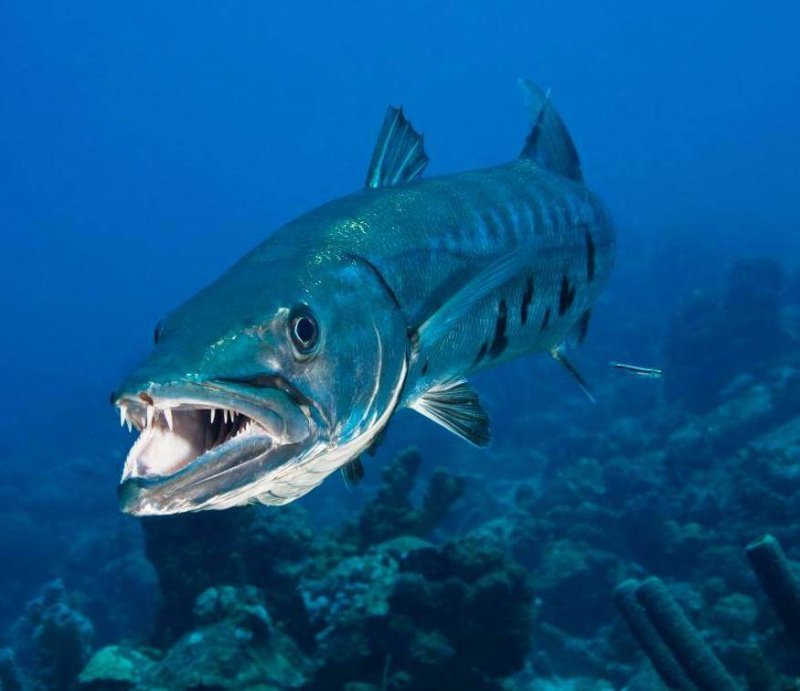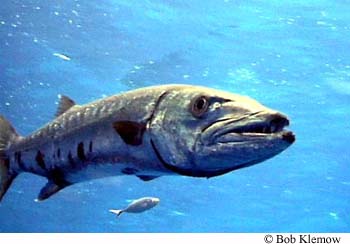The Barracuda commonly occurs in nearshore coral reefs, seagrasses, and mangroves. They may also reside in the open ocean, living predominantly at or near the surface, although they are sometimes found at depths of 325 feet deep. What are Ideal Water Conditions for Barracuda?
- Temperature: 75-85°F (24-29°C)
- Salinity: 32-37 ppt
- pH: 7.5-8.5
- Water quality: Low ammonia, nitrite; <20 ppm nitrate
- Oxygenation: >5 mg/L dissolved oxygen
- Water flow: Moderate to strong
- Tank size: Minimum 75 gallons for juveniles, 150 gallons for adults
- Stability: Maintain stable conditions to prevent stress
Barracuda live in tropical areas all around the world. When they are small they tend to live in shallow bays and other nearshore areas. As they get larger they tend to move out to reefs and wrecks farther offshore. They are blindingly fast over short distances and cut their prey in half with their mouth full of jagged teeth. They grow to around 100 lbs.
Introduction:
A Barracuda’s body is shaped like a torpedo and made for cutting through the water. This long, lean, and muscular fish is one of the fastest creatures in the sea, capable of swimming up to 35 mph.

Barracudas, with their sleek bodies and razor-sharp teeth, are among the most formidable predators in tropical and subtropical oceans. These long and slender fish are known for their swift movements and voracious appetites, making them both fascinating and intimidating creatures of the sea.
However, behind their fearsome reputation lies a delicate balance of environmental factors crucial to their health and well-being. Just like any other aquatic species, barracudas rely heavily on maintaining suitable water conditions to thrive in their natural habitats or captivity. From temperature and salinity levels to water quality and oxygenation, each aspect plays a vital role in ensuring their longevity and vitality.
In this article, we will look into the world of Barracudas, exploring the significance of maintaining optimal water conditions for their health and well-being. By understanding the specific needs of these remarkable fish, we can better appreciate the importance of creating and sustaining environments that mimic their natural habitats. Take a look into the world of Barracudas and the critical role of water conditions in their lives.
- Scientific Name: Sphyraenidae
- Common Name: Barracuda
- Basic Animal Group: Fish
- Size: 20 inches to 6 feet or more
- Weight: Up to 110 pounds
- Lifespan: Varies by species; giant barracudas live up to 14 years
- Speed: Up to 35 miles per hour
- Diet: Carnivore
- Habitat: Atlantic, Pacific, and Indian Oceans, Caribbean and Red Seas
What are Ideal Water Conditions for Barracuda
Ideal Tide for Barracuda Fishing
Ideal Weather and Barometer Pressure for Barracuda Fishing
Conclusion:
In conclusion, maintaining ideal water conditions is crucial for the health and well-being of barracudas, whether in their natural habitat or in captivity. Here’s a recap of the key points regarding ideal water conditions for barracudas:
- Temperature: Barracudas thrive in water temperatures ranging from 75°F to 85°F (24°C to 29°C), reflecting their preference for tropical and subtropical environments.
- Salinity: Marine barracudas prefer stable salinity levels typical of seawater, ranging from 32 to 37 parts per thousand (ppt), which should be maintained in aquariums or enclosures.
- pH Level: The ideal pH range for barracudas is between 7.5 and 8.5, reflecting the alkaline conditions found in their natural marine habitats.
- Water Quality: Monitoring and maintaining water quality parameters such as ammonia, nitrite, nitrate levels, and dissolved oxygen are essential for the health of barracudas. Aim for ammonia and nitrite levels below 0.25 ppm and nitrate levels below 20 ppm.
- Oxygenation: Adequate oxygenation is crucial for barracuda health and vitality. Ensure sufficient water circulation, aeration, and surface agitation to maintain dissolved oxygen levels above 5 mg/L.
- Water Flow: Moderate to strong water flow patterns should be provided in the aquarium to simulate natural conditions and prevent stagnation.
- Tank Size: Barracudas require spacious aquariums to swim and exhibit natural behaviors. A minimum tank capacity of 75 gallons for juveniles and at least 150 gallons for adults is recommended.
By adhering to these guidelines and closely monitoring water parameters, aquarists can create and maintain optimal water conditions for barracudas, promoting their health, vitality, and overall well-being in captivity. Regular observation and adjustments are essential to ensure the long-term success of keeping barracudas in aquariums or enclosures.
References:
Thought Co- Barracuda Fishing, Behavior Habitat
FAQ’s
What are the predators of barracudas? Barracudas are apex predators in their ecosystems and have few natural predators. Larger sharks, such as bull sharks and tiger sharks, are among the primary predators of barracudas, along with other large predatory fish species. Additionally, barracuda eggs and juveniles may be preyed upon by smaller predators such as larger fish and marine mammals
Where are barracudas found? Barracudas are found in tropical and subtropical waters around the world, including the Atlantic, Indian, and Pacific Oceans. They inhabit a variety of marine environments, including coral reefs, seagrass beds, coastal areas, and open ocean habitats.
What do barracudas eat? Barracudas are opportunistic predators and feed on a variety of prey, including smaller fish, crustaceans, and occasionally squid or other marine creatures. They are known for their swift attacks and sharp teeth, which they use to capture and consume their prey.
Are barracudas dangerous to humans? While barracudas are not typically aggressive towards humans, they have been known to exhibit territorial behavior and may attack if provoked or feel threatened. Additionally, their sharp teeth can cause serious injuries if bitten. It’s essential to exercise caution and respect when encountering barracudas in their natural habitat.





